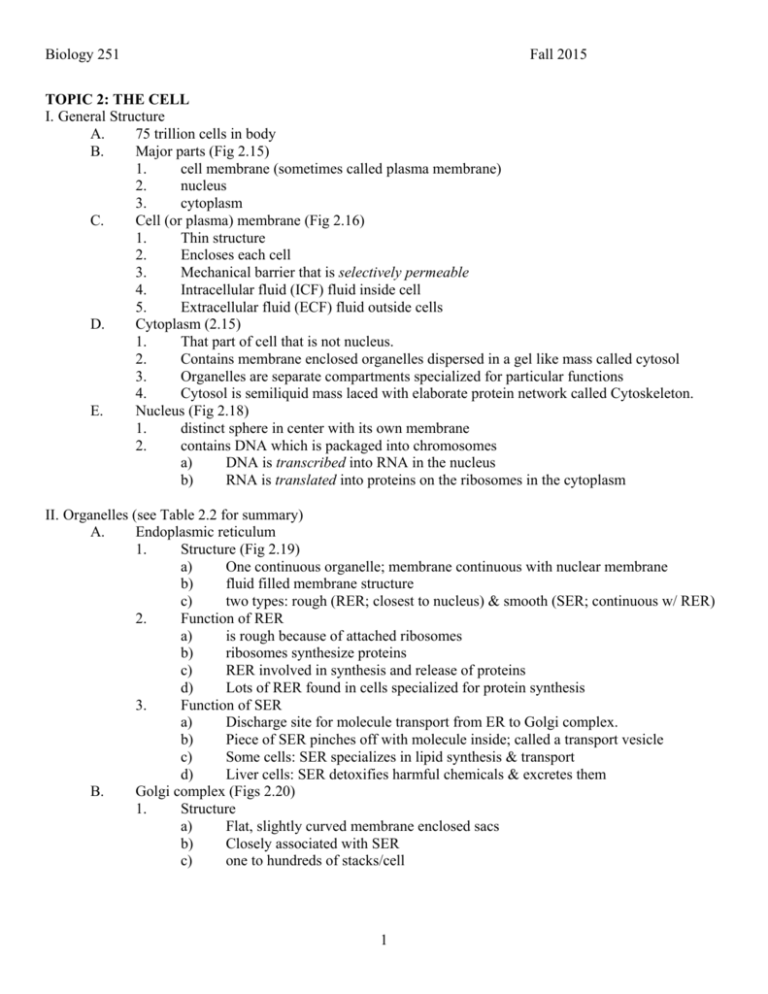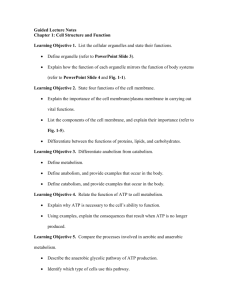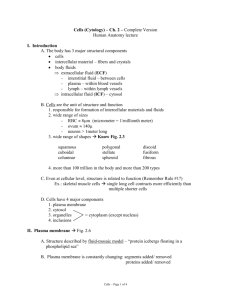Biology 251 Fall 2015 1 TOPIC 2: THE CELL I. General Structure A
advertisement

Biology 251 Fall 2015 TOPIC 2: THE CELL I. General Structure A. 75 trillion cells in body B. Major parts (Fig 2.15) 1. cell membrane (sometimes called plasma membrane) 2. nucleus 3. cytoplasm C. Cell (or plasma) membrane (Fig 2.16) 1. Thin structure 2. Encloses each cell 3. Mechanical barrier that is selectively permeable 4. Intracellular fluid (ICF) fluid inside cell 5. Extracellular fluid (ECF) fluid outside cells D. Cytoplasm (2.15) 1. That part of cell that is not nucleus. 2. Contains membrane enclosed organelles dispersed in a gel like mass called cytosol 3. Organelles are separate compartments specialized for particular functions 4. Cytosol is semiliquid mass laced with elaborate protein network called Cytoskeleton. E. Nucleus (Fig 2.18) 1. distinct sphere in center with its own membrane 2. contains DNA which is packaged into chromosomes a) DNA is transcribed into RNA in the nucleus b) RNA is translated into proteins on the ribosomes in the cytoplasm II. Organelles (see Table 2.2 for summary) A. Endoplasmic reticulum 1. Structure (Fig 2.19) a) One continuous organelle; membrane continuous with nuclear membrane b) fluid filled membrane structure c) two types: rough (RER; closest to nucleus) & smooth (SER; continuous w/ RER) 2. Function of RER a) is rough because of attached ribosomes b) ribosomes synthesize proteins c) RER involved in synthesis and release of proteins d) Lots of RER found in cells specialized for protein synthesis 3. Function of SER a) Discharge site for molecule transport from ER to Golgi complex. b) Piece of SER pinches off with molecule inside; called a transport vesicle c) Some cells: SER specializes in lipid synthesis & transport d) Liver cells: SER detoxifies harmful chemicals & excretes them B. Golgi complex (Figs 2.20) 1. Structure a) Flat, slightly curved membrane enclosed sacs b) Closely associated with SER c) one to hundreds of stacks/cell 1 Biology 251 Fall 2015 2. Function a) Destination point for ER transport vesicle b) Processes proteins from ER into final form c) Sort & direct finished products to final destination in or out of cell C. Lysosomes (Fig 2.22) 1. Structure a) Membrane enclosed sacs derived from Golgi complex b) Contain powerful hydrolytic enzymes 2. Function a) Digest cellular debris & foreign material b) Can also digest aged and damaged organelles c) Injured or dead cell: lysosomes rupture & digest whole cell D. Mitochondria (Fig 2.21) 1. Structure a) Bacteria sized rod or oval shaped b) Outer membrane surrounds mitochondria c) Inner membrane that forms infoldings called cristae d) Inner membrane projects into cavity called matrix 2. Function a) Powerhouse of cell b) Produce high energy molecules (ATP) in presence of oxygen III. Cytosol (Fig 2.15) A. Structure 1. Semiliquid highly organized gelatinous mass 2. 55% of cell volume B. Function 1. Intermediary metabolism a) metabolism of small organic molecules b) glycolysis (see below) 2. Protein synthesis on free ribosomes a) proteins needed in cytosol itself (e.g. glycolytic enzymes) 3. Storage of fat and glycogen IV. Cytoskeleton (Fig 2.24) A. Overview 1. “Bone and muscle” of cell 2. Permeates cytosol B. Microtubules (Fig 2.26) 1. Structure a) Largest of cytoskeletal elements b) Slender, long hollow straight tubes c) Composed of small globular protein called tubulin 2. Function a) Maintain asymmetrical cell shape (e.g. axons) b) Secretory vesicles transported down Microtubules by motor proteins c) Dominant components of cilia & flagella which are used to move materials across cell surface or to propel cell 2 Biology 251 C. Fall 2015 d) Forms mitotic spindle which organizes chromosomes during mitosis Microflilaments (Fig 2.25) 1. Structure a) Smallest of cytoskeletal elements b) Usually composed of small globular protein called actin c) Usually two strands of actin twisted together 2. Function a) Part of contractile systems within cell (1) cell locomotion (2) split cell during mitosis b) mechanical stiffeners (1) microvilli-projections from gut epithelium V. Cellular Energetics: Oxidation of Glucose A. Cellular Energy (Fig 3.13) 1. ATP → ADP + Pi + energy 2. Energy stored as ATP can be used to run cellular processes a) Synthesis of new compounds b) Membrane transport c) Mechanical work (e.g., muscle contraction) B. Glycolysis (Fig 3.15) in Cytosol 1. Aerobic: 1 x 6-carbon glucose → 2 x 3-carbon pyruvate + 2 ATP + 2 reduced coenzymes C. Linking Step (Fig 3.16) in Mitochondria 1. 2 Pyruvate converted to 2 Acetyl CoA + 2 reduced coenzymes 2. 2 CO2 produced (waste) D. Krebs Cycle (Fig 3.18) in Mitochondria 1. Aerobic (requires O2) 2. 2 Acetyl CoA consumed; 2 ATP, 8 reduced coenzymes and 4 CO2 produced. E. Oxidative phosphorylation (Fig 3.21) in Mitochondria 1. The 12 reduced coenyzmes produced by glycolysis, linking step and Krebs cycle pass through inner membrane of mitochondria (electron transport chain) and the energy is converted to energy stored in chemical bonds of ATP (chemiosmotic coupling). 2. The 12 H2 molecules released by the coenzymes as part of this energy conversion process react with Oxygen to form water 3. Produces 34 ATP and 12 H2O. F. Summary of glucose oxidation (Fig 3.22) 1. Aerobic: 38 ATP/glucose (2 from glycolysis, 2 from Krebs, and 34 from oxidative phosphorylation) G. Overall Reactions 1. food + O2 converted to CO2 + H2O + ATP 2. this is similar to a controlled wood fire VI. Anaerobic respiration (Fig 3.23): No oxygen available 1. Glycolysis runs but pyruvate converted to lactate 2. Krebs cycle and oxidative phosphorylation can not occur without oxygen 3. 2 ATP/glucose produced. 3






